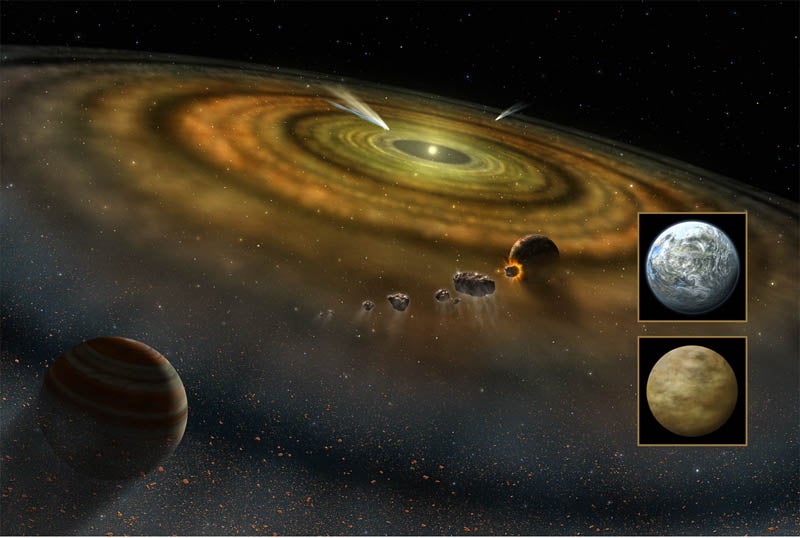Every pictor tells a story
ListenChinese spacecraft Change’e 5T1 launched last Wednesday, did a swing around the moon and is now on its way back to Earth. Because of the very high apogee above the moon, 380,000 kms, an excellent photo of Earth and the moon was taken. Astronomers have identified two families of comets orbiting the star Beta Pictoris in the southern sky. The discovery allows scientists to further compare our solar systems with others in various stages of development to better understand how our solar system came to its current state. Mars still looks good in the evening SW sky. Jupiter still stunning high in the pre-dawn sky 45 minutes before sunrise. Constellation Cygnus in the west at 10p, with Taurus in the east simultaneously. Summer and Winter stars.
November 3, 2014
[Dave Heller] Check out [an] out-of-this-world image of the moon cozying up to planet Earth. Let’s get the full picture with Derrick Pitts, chief astronomer at the Franklin Institute. Derrick, this one comes courtesy of China?
[Derrick Pitts] Yes it does come to us courtesy of China. The way we get this picture is from the most recent Chinese space mission in which a spacecraft was sent to orbit the moon. And actually to not even orbit the moon, just do a slingshot around the moon as part of a test flight of an upcoming Chinese mission to the moon that will be a lunar sample return mission.
So in the course of doing this engineering feat, there was obviously time to take some pretty pictures.
Actually, it was kind of interesting how they got to take this picture. The picture that was taken shows us both the Earth and the moon in one frame. And that’s kind of difficult to do because you have to have enough distance from the two to be able to get this kind of perspective shot. There aren’t many pictures of the Earth and moon together; typically they seem to be taken by spacecraft that are out beyond the orbits of Mars where you do have enough distance to see the two in the same frame. And a lot of it has to do with trajectory of the spacecraft also. But in this case, it turns out that the apogee of the Chinese spacecraft above the moon was 380,000 kilometers, and that’s high enough, a good enough distance away to be able to get this really unique shot of the Earth and moon together.
And a spoiler alert: The Earth is rather small but beautifully blue and the moon is large by contrast and almost a black and white.
Almost — And it certainly shows the perspective of the view of the spacecraft, because as you said, the moon looks much larger and of course they’re closer to it than they are to the Earth, so the Earth looks a lot smaller. We have to keep in perspective the idea that the moon is only a quarter of the size of the Earth.
Back to China. What’s their ultimate aim regarding launches to the moon?
Well, they have a series of missions coming up over the next decade or so in which they plan to send spacecraft to the moon, pick up samples, bring them back and perhaps even send astronauts to the moon as well. But that’s very, very long term; although the missions to do research on the planet’s surface are much more immediate and they really are well on their way to accomplishing that.
-

A woman is silhouetted by posters describing an exhibit on the moon at the China Science and Technology Museum in Beijing Sunday, Dec. 15, 2013. China’s first moon rover touched the lunar surface and left deep traces on its loose soil, state media reported Sunday, several hours after the country successfully carried out the world’s first soft landing of a space probe on the moon in nearly four decades. (AP Photo/Ng Han Guan)
Let’s head out of this world, out of our solar system to other ones that also apparently comets in orbit.
It is so much fun realizing how other solar systems are built as we’re discovering new exoplanets orbiting other stars. One star in the southern hemisphere sky called Beta Pictoris — it’s the second brightest star in the constellation Pictor — does have comets. And it turns out it has several families, two families, of comets. Not it’s not new that we’re learning that stars have comets. We’ve been observing objects in the Beta Pictoris system that look like comets for a few years now. The most interesting thing about them that we’re discovering is that these comets seem to tell a story of their involvement in this particular star system. Some of these comets seem to be from an older family than the other group of comets. Now what astronomers are hoping to get from this is a better understanding of the history of the development of not only comets in our solar system but our solar system as a whole. We often use comets as a way to gauge what the early conditions were like in our solar system because comets come to the center of our solar system from a tremendous distance out of the Ort cloud, almost 100 astronomical units out. And because they’re so far away, they preserve the elements, and inf you will, the environment in a sense of what the early solar system was like. It’s almost like we’re taking an ice core. As we take ice cores from our planet’s polar caps, we find out what earlier atmospheres were like; and looking at comets for us is like looking back and seeing what our earliest solar system history was like.
Quick refresher: What’s a comet, and how is it different than an asteroid?
Well, a comet is just a dirty, frozen snowball in a way. It’s a ball composed of frozen carbon dioxide with detritus mixed into it, like dust and dirt —
Herbs and spices?
Herbs and spices left over from the beginning of the solar system, all trapped inside this icy body. And as it travels around the solar system, coming close to the sun on its perihelion passages, well that nucleus of frozen carbon dioxide melts. And as it melts it turns into gas and that detritus is loosened from the frozen ball and gases are pushed out behind the comet by the solar wind creating a tail. Asteroids are hunks of rock that seem to come from the interiors of planets that existed before. It’s not news that in our solar system’s early history we had more planets than we have now. But the dynamics of the early solar system either broke those planets up into smaller pieces that we call asteroids, or has flung those bodies out of the solar system entirely. And then we also have the pieces where some were captured in the early solar system and are not original parts of our early solar system.
-

Various planet formation processes, including exocomets and other planetesimals, around Beta Pictoris, a very young type A V star (NASA artist’s conception).
Derrick, we have a moment left — what hunks of rock are available to be seen in the night sky this week?
Evening sky right after sunset over in the southwest we see Mars. Looks really great, particularly in a pair of binoculars, and easy to identify — pinkish twinge, doesn’t twinkle unlike stars that do twinkle. In the morning sky 45 minutes before sunrise, Jupiter rules high in the east. Looks really great also in a pair of binoculars. That’s a good view. And we have great constellations — The constellation Cygnus, the swan in the summer, high in the west at about 9, 10:00 in the evening. While simultaneously over on the eastern side of the sky, again 10 p.m. in the evening, we find the constellation Taurus telling us that winter is on the way.
WHYY is your source for fact-based, in-depth journalism and information. As a nonprofit organization, we rely on financial support from readers like you. Please give today.





